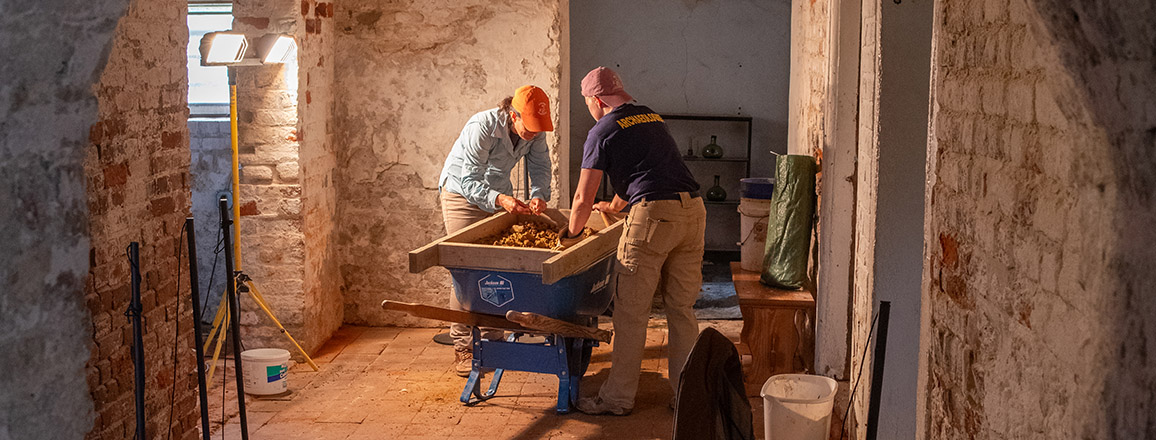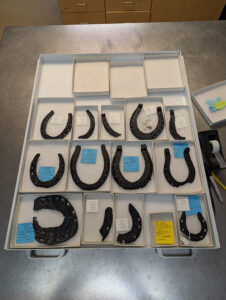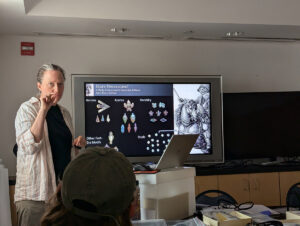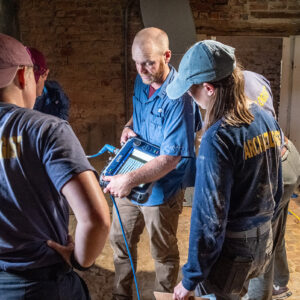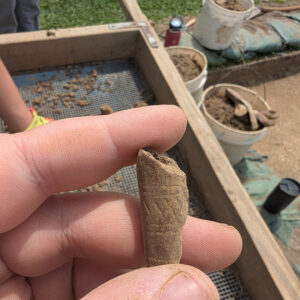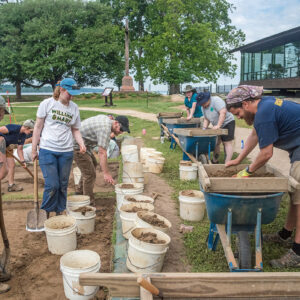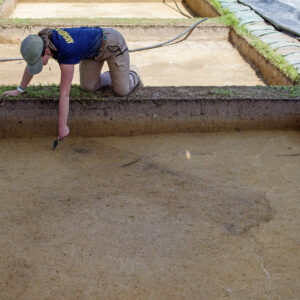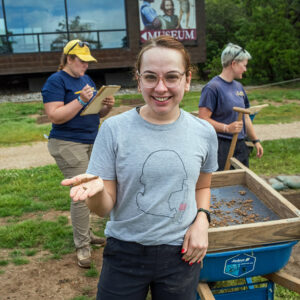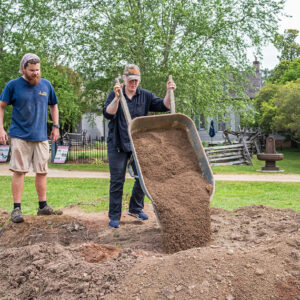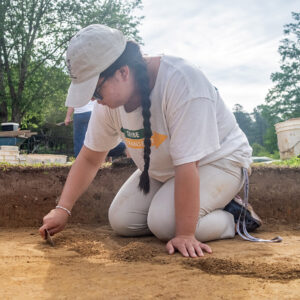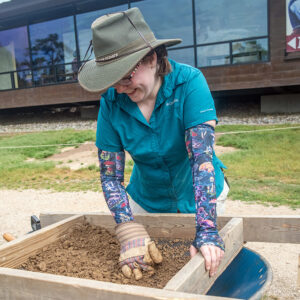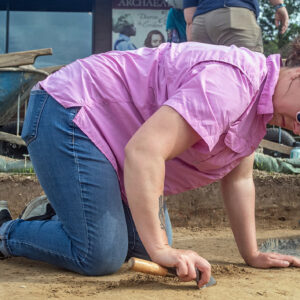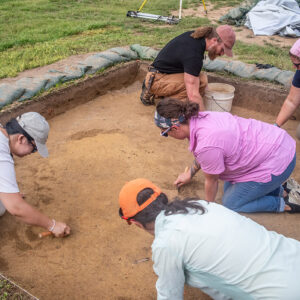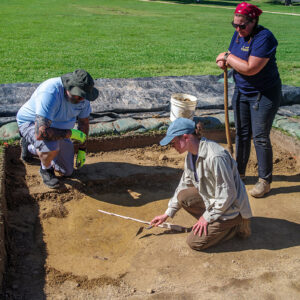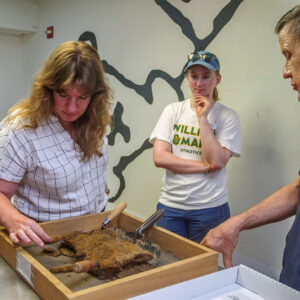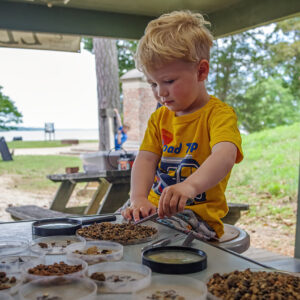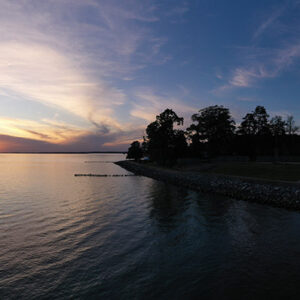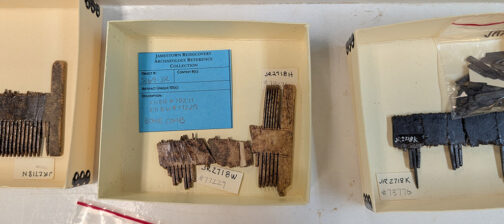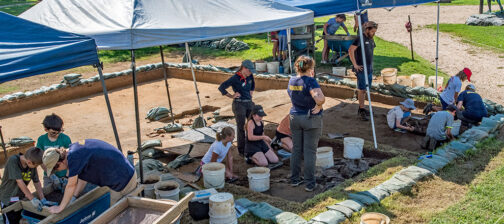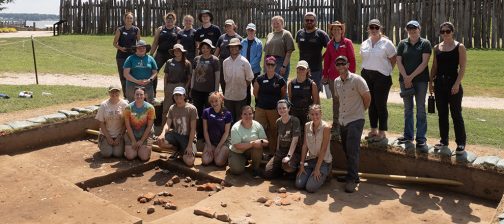
As opening day of the 2025 Jamestown Field School approaches the archaeology team is preparing the various excavation sites that they’ll be working on. One is a potential brick-lined cellar to the north of the Memorial Church that was discovered in 2023 by ground-penetrating radar (GPR). This feature is right in the middle of property known to belong to John Howard in the late 17th century. The identification of his property is part of an ongoing project studying Jamestown land patents and matching them to the excavated landscape. John Howard’s initial land patent, dated April 10, 1694, described his property as bordered by the churchyard to the south and the Great Road to the east. By examining excavations from the previous 31 years of the project, Senior Staff Archaeologists Mary Anna Hartley and Anna Shackelford identified a number of ditches and fence lines that match the survey measurements on John Howard’s land grant. Previous archaeology had also uncovered portions of the Great Road northeast of the Church, allowing the team to place Howard’s property on the landscape.
The GPR indicates the potential cellar measures approximately 16′ x 24′ but we don’t know yet if the house above it also shared those dimensions. The plan is expose the north wall of the cellar and follow it until the team finds the rest of the foundations. Once that is done, they will then dig inside the cellar. There are several burials in the immediate vicinity, found both by Jamestown Rediscovery archaeologists and by a team led by J.C. Harrington in the 1940s. Another goal of the team during these excavations is to look for clues that might help date these burials.
The other sites the Field School crew will excavate this season are an area just south of the Archaearium, the possible artillery barracks site, and the exploratory line of 5’x 5′ squares across Smithfield. The students will rotate through the different sites every two weeks so that they experience the different learning opportunities and challenges each has to offer. Each site will be led by one or more of our archaeologists who will work side-by-side with the students, giving guidance and answering questions.
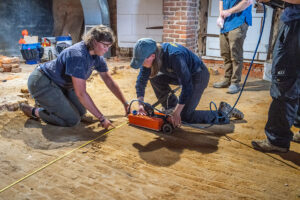
Our archaeologists took the ferry across the James River to Surry County this month to lend a hand to another Preservation Virginia property, Bacon’s Castle. The older, central portion of Bacon’s Castle was built in 1665, making it the oldest extant brick dwelling in North America. Our team brought their GPR equipment with them as well as their shovels and trowels to do some archaeology in the building’s cellar. Preservation Virginia is installing a new fire suppression system in the building and a concrete slab will be installed in the cellar to support some of that infrastructure. Before the concrete could be poured, sealing any archaeological resources beneath it, Preservation Virginia asked the team to do a survey of the affected area. Descendants of the families who lived and worked on the property were invited and came to watch them work. The archaeologists used both 300 MHz and 900 MHz GPR antennae and then conducted shovel-in-ground excavations, finding the builder’s trench for the cellar wall and a posthole. The artifacts found during the dig included mostly architectural materials such as brick, mortar, and window glass.
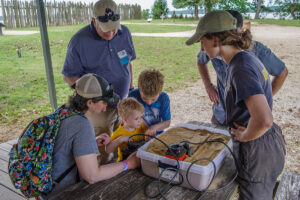
The Ed Shed is back open for the summer season. Interns Faith and Nora, both students at William & Mary, are helping visitors learn the basics of archaeology through hands-on activities. Ed Shed visitors can pick through material excavated from Jamestown’s first well, also called the John Smith Well as he ordered its construction late in 1608 or early in 1609. Faith and Nora are also picking through the material and have found tiny beads, lead shot, and animal bones. All of this information will be cataloged and will add to our understanding of the colonists’ activities and their diets during the early fort years. New for 2025 in the Ed Shed is “GPR Tuesdays” where visitors can use GPR to find buried objects in a small sandbox environment. This hands-on activity will use the same technology our archaeologists use in the field to find features and artifacts and will give visitors a better understanding of this increasingly-indispensible tool.
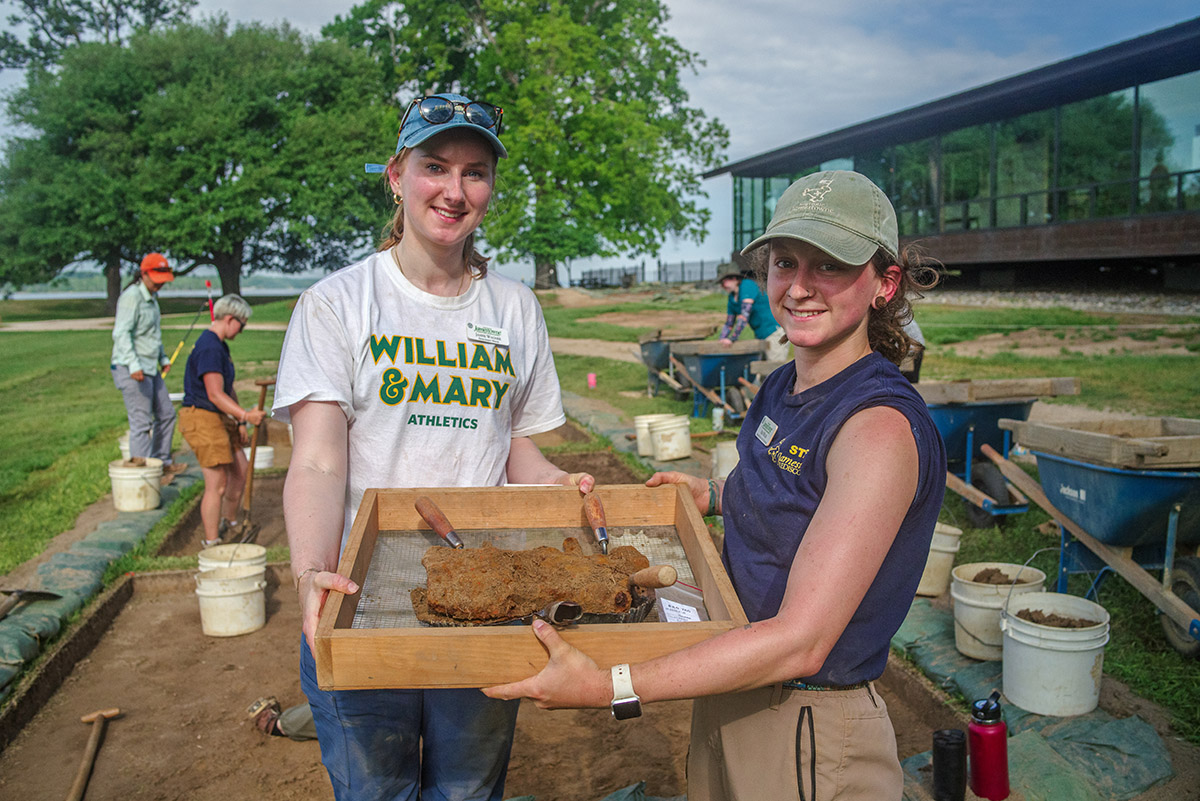
The archaeology staff offered several staff dig days this month for the Jamestown Rediscovery employees — whether they be in ticketing, development, conservation, maintenance, or other support roles — who aren’t typically outside helping with the excavations. With archaeologists supervising, the employees tried their hands at shoveling, troweling, and screening excavated dirt for artifacts in a number of newly-opened squares in north Smithfield. Like other areas of Smithfield this far north the plowzone is very thin, only 3 or 4 inches, indicating much of this area’s soil was removed. The removal was likely done by the Association for the Preservation of Virginia Antiquities (now Preservation Virginia) early in the 20th century, as part of landscaping efforts. The team found a new confirmed burial and another possible one during these excavations as well as a large iron object that is still unidentified even after being X-rayed. The utility lines found during last month’s dig in Smithfield were also found here. This author at least gained a further appreciation for the efforts of the archaeology crew and also for his desk job.

The archaeological team is happy to welcome Katie Griffith back into the fold, this time as a full time Archaeological Field Technician. Katie was a member of the 2023 Field School and came back for a 12-week internship in 2024. She has completed her studies at the University of Cincinnati where she received a B.A. in archaeology and a B.F.A. in ballet. Katie will come full circle as this year’s field school will start late this month but this time she’ll be helping by passing on the skills she learned here and in school.
The curatorial staff has completed their work on the crucible collection (until more sherds are found in the field anyway!). There are a total of 2,281 sherds and at least 93 vessels in the collection. Of the vessels, 61 are triangular and 23 are beaker-shaped. The mending process is complete and all the relevant information has been entered into our database. Interestingly, more of the crucibles are unused than used. This may be due to the settlers giving up on metallurgy and glassmaking as a money maker, especially with the success of tobacco in the 1610s.
Associate Curator Janene Johnston has now turned her attention to creating a reference collection for Jamestown’s horseshoes. There are about 20 in the collection, including one that was found this spring southwest of the Archaearium. Janene weeded out some pieces of iron that resembled horseshoes but had no nail holes or weren’t whole enough to be positively identified. Those examples found in 17th-century contexts tend to be thinner and exhibit unique characteristics because each was hand-made. They are all conserved and those not on display in the Archaearium will be housed in the Dry Room, where humidity and temperature are monitored and adjusted to inhibit corrosion.
Conservator Don Warmke continues his work at the X-ray machine. Don’s goal is to take an X-ray of all iron objects that aren’t obviously nails. These X-rays inform the collections team’s decisions on the priorities of artifact conservation. If the X-ray reveals an artifact to be rare, unusual, or could advance our knowledge of Jamestown’s history while also benefitting from the conservation process, it could receive a high priority for our conservators and curators to be treated. Some artifacts have so little original metal remaining (due to hundreds of years of chemical corrosion, i.e. “rust”) that conservation attempts would irreparably harm what’s left. This is a case of “first do no harm” similar to the thought process of a doctor as they decide what’s best for their patient. Don has taken close to 200 X-rays in May, each of which are uploaded to the corresponding artifact’s record in our database.
Assistant Curator Magen Hodapp has spent quite a bit of time in the “Dead Shed” (as opposed to our “Ed Shed”) setting up a water maceration environment for some of our recently-deceased animals which bones we want to keep for our comparative collection. The collection houses skeletons of animals which our collections team can use to compare to artifacts, making it easier to identify the excavated faunal remains. Magen has submerged the remains in water, allowing the naturally occurring anaerobic bacteria present in the water to consume the animals’ flesh. This process allows us to more speedily reach the goal of having just a skeleton. Magen is currently using water maceration to process an iguana (provided by the Jamestown-Yorktown Foundation), a sturgeon, and a gar (both provided by the Virginia Institute of Marine Sciences).

We are happy to welcome longtime intern Lindsay Bliss to a fulltime position as a Collections Assistant this month. Lindsay has been working in the lab, Vault, and along the Seawall for years now. One of her projects as an intern has been to float soil samples set aside from years of excavations. This process uses water to separate artifacts from soil and further divide the artifacts by density. She has also maintained the flotation tank which is quite the job in itself. She is striving to make it as watertight as possible, so that tiny artifacts aren’t lost during the process. The repairs have been an iterative process and she’s using poppy seeds as stand-ins for artifacts to test the effectiveness of her efforts. In the latest flotation run she recovered 95 out of 100 seeds which is a great recovery rate though this was without soil in the equation. Next she will repeat the process with soil added, greatly complicating the “artifact” recovery but more accurately emulating the archaeological process. Lindsay received her B.A. in Anthropology from Southern New Hampshire University and her M.A. in Anthropology from William & Mary. Her master’s thesis focused on the impact of sea level rise on archaeology sites on Rurutu, an island in French Polynesia which she visited twice for several weeks to do her research. Of the seven archaeological sites she studied only two are predicted to be above water by 2100, when 2 meters of sea level rise will cause land 200 meters from the current shoreline to be inundated.
The Jamestown Rediscovery staff enjoyed two presentations this month by scholars who studied our collection as part of their academic research. Dr. Cathrine Davis successfully defended her dissertation “Though many have scarce raggs to covr their naked bodyes:” Utilizing Lead Cloth Seals to Interrogate Textile Importation, Use, and Maintenance at Jamestown, Virginia (1606-1630) to members of the William & Mary anthropology department. The defense was open to the public and many including our own staff attended both in-person and via Zoom. Lead seals are small lead labels attached to textiles and other goods that gave information about their origin, their inspection and tariff process, and their quality. As part of her research Dr. Davis studied the approximately 300 lead seals in the Jamestown collection while also categorizing and photographing them. You can read more about Jamestown’s lead seals on the lead seals webpage or by watching Dr. Davis talk about them on our YouTube channel.
Also in May we were visited by Sara Rivers Cofield, Curator of Federal Collections at the Maryland Archaeological Conservation Laboratory (MAC Lab). Ms. Rivers Cofield has been studying equestrian artifacts from the colonial Chesapeake region. Her goal is to identify the artifacts and research what the type and quantity indicate about the way horses were used by the colonists. Ms. Rivers Cofield has visited Jamestown several times as part of this research, helping us by applying her expertise to identify equestrian artifacts while she’s studying them. She also took photographs of the artifacts during the process. All of this information was then entered into our database by our curatorial staff. Learn more about Ms. Rivers Cofield’s research by watching a lecture she gave on the subject at Historic St. Mary’s City in 2023. Ms. Rivers Cofield was in town to assist Associate Curator Janene Johnston in pinning down dates and functions of some of the trickier buttons in the Jamestown collection, bringing examples from the MAC Lab to aid in the process.
dig deeper
related images
- Senior Staff Archaeologist Mary Anna Hartley and Staff Archaeologist Caitlin Delmas screen through soil excavated from Bacon’s Castle’s cellar.
- Staff Archaeologist Natalie Reid and Senior Staff Archaeologist Anna Shackelford excavate a square in the cellar of Bacon’s Castle.
- Staff Archaeologist Cailtin Delmas looks for artifacts in soil excavated from Bacon’s Castle’s cellar.
- Director of Archaeology Sean Romo discusses GPR data with his team in the cellar of Bacon’s Castle.
- A partial pipe stem found by Assistant Conservator Jo Hoppe on one of the staff dig days.
- During one of the staff dig days archaeologists and other Jamestown Rediscovery staff excavate squares just south of the Archaearium.
- Staff Archaeologist Ren Willis scores a burial found south of the Archaearium this month.
- Director of Communications & Marketing Angel Johnston holds a nail she found while screening through material on one of the staff dig days.
- Erin Forys, Visitor Services Lead, dumps a pile of screened dirt as Archaeological Field Technician Josh Barber looks on.
- Development Assistant Korinne Young carefully trowels away south of the Archaearium during one of the staff dig days.
- Office & Development Administrator Katie Kowicki screens through soil just south of the Archaearium during one of the staff dig days.
- Grants Administrator Dr. Emelia Robertson at work during one of the staff dig days.
- Korinne Young and Emelia Robertson, both members of the development team, and carpenter Jesse Robertson join Senior Staff Archaeologist Mary Anna Hartley and Archaeological Field Technician Hannah Barch in excavations on one of the staff dig days.
- Aaron McKee of the grounds and maintenance team watches Staff Archaeologist Natalie Reid score a burial found south of the Archaearium on a staff dig day. Archaeological Field Technician Hannah Barch looks on.
- Senior Curator Leah Stricker, Development Writer Janne Wagner, and Conservator Don Warmke discuss the iron object Janne found during one of the staff dig days. Janne was an attendee of Jamestown’s 2023 Field School.
- Director of Archaeology Sean Romo gives the archaeological tour which occurs every weekday at 11 a.m. from late March to late November.
- A young visitor to the Ed Shed looks for artifacts in material excavated from John Smith’s Well.
- Sara Rivers Cofield shares equestrian artifacts with members of Jamestown’s archaeological and collections staffs.
- A sunset panorama of Jamestown taken by drone


